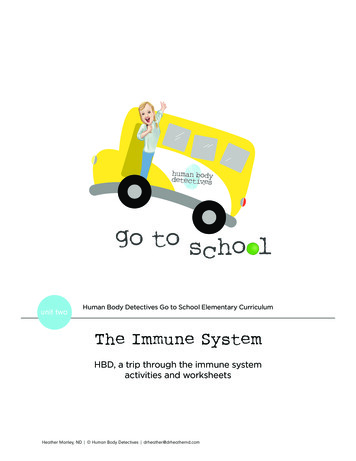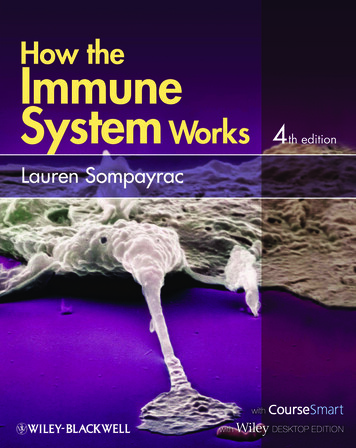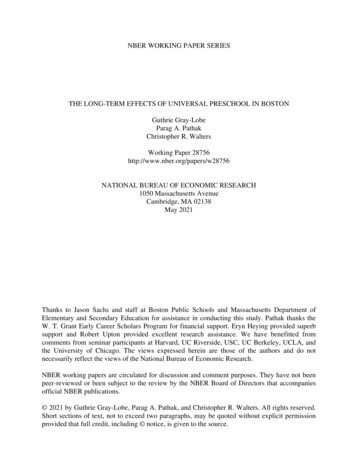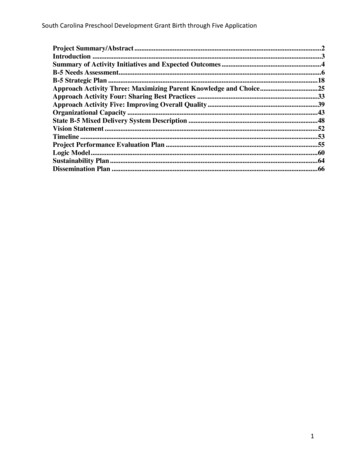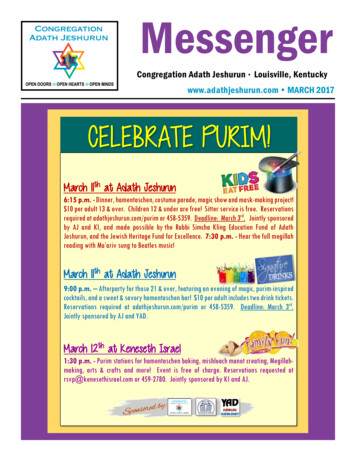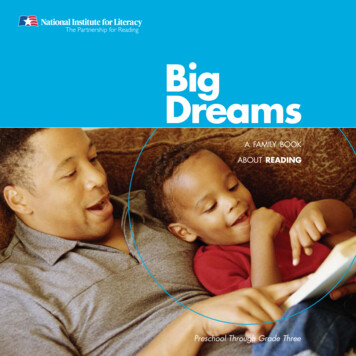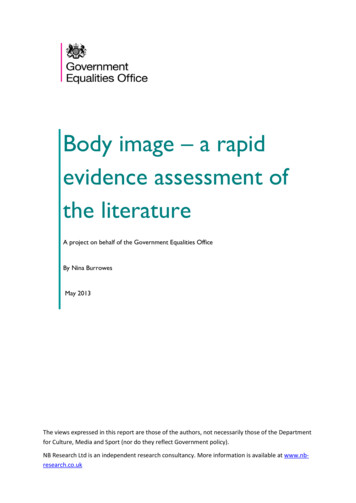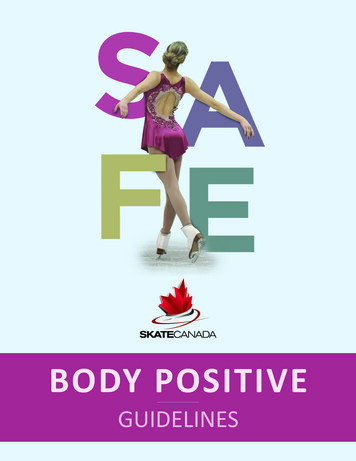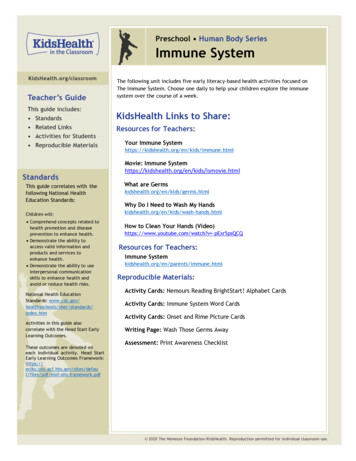
Transcription
Preschool Human Body SeriesImmune SystemThe following unit includes five early literacy-based health activities focused onThe Immune System. Choose one daily to help your children explore the immunesystem over the course of a week.KidsHealth Links to Share:Resources for Teachers:Your Immune vie: Immune SystemStandardsThis guide correlates with thefollowing National HealthEducation Standards:Children will: Comprehend concepts related tohealth promotion and diseaseprevention to enhance health. Demonstrate the ability toaccess valid information andproducts and services toenhance health. Demonstrate the ability to useinterpersonal communicationskills to enhance health andavoid or reduce health risks.National Health EducationStandards: mActivities in this guide alsocorrelate with the Head Start EarlyLearning Outcomes.These outcomes are denoted oneach individual activity. Head StartEarly Learning Outcomes lth.org/en/kids/ismovie.htmlWhat are Germskidshealth.org/en/kids/germs.htmlWhy Do I Need to Wash My Handskidshealth.org/en/kids/wash-hands.htmlHow to Clean Your Hands (Video)https://www.youtube.com/watch?v -pExr5psQCQResources for Teachers:Immune cible Materials:Activity Cards: Nemours Reading BrightStart! Alphabet CardsActivity Cards: Immune System Word CardsActivity Cards: Onset and Rime Picture CardsWriting Page: Wash Those Germs AwayAssessment: Print Awareness Checklist 2020 The Nemours Foundation/KidsHealth. Reproduction permitted for individual classroom use.ÓÓÓ 2020 The Nemours Foundation/KidsHealth. Reproduction permitted for individual classroom use.
Preschool Human Body SeriesImmune SystemExploring the Immune SystemLiteracy Standard:This activity correlates with the following Head Start Early Learning Outcomes:Children will: P-LC2: Understand and respond to increasingly complex communication and language from others. P-LC6: Understand and use a wide variety of words for a variety of purposes.Objectives:Children will: Describe what the immune system is and how it works to keep them healthy. Identify ways to keep themselves and others healthy.Materials: Suggested book — My Immune System — Emily Raij (or any age-appropriate book about The Immune System) Chart paper Colorful markersClass Time:15 - 20 minutesActivity:Clarify Learning ObjectivesThis week, we are learning about the immune system and how to keep our bodies healthy. Today, I brought in a bookfor us to read together and learn about the immune system. I also brought chart paper and colorful markers, so wecan make a chart of what to do to keep ourselves healthy and to do to keep others healthy. Who’s ready to learnabout the immune system?Introduce the Book Demonstrate proper book handling and point to each word of the title as you read:Uh oh! I picked up the book upside and backward. This is the back of the book! We can’t start reading here, can we?No way! Watch how I turn, turn the book to the front cover so I can find the title and author of this book. Is this thefront cover? Yes, we found the front. Now, let’s find the title and the author! This book is called My ImmuneSystem. It is written by Emily Raij. Allow children to see the front and/or back cover of the book to make predictions:Do you see the little boy laying with his pillow and blanket on the cover of our book? It looks like he has athermometer in his mouth! What do you think this book will be about? Those are great guesses! This book is aboutthe immune system in your body. The immune system helps keep you healthy by fighting germs.Why do you think the author wrote this book? What does she want us to learn? Let’s take a quick flip through thepictures inside to see if it helps us answer those questions. Those are all great answers! It looks like the authorwrote this book to help us learn about our immune system, how it works, and how we can help to keep ourselveshealthy! Let’s read together to find out more.Read and Introduce Vocabulary As you read, include opportunities for discussion and introduce vocabulary:The book says, “My immune system will keep me healthy!” Does anyone know what the immune system is? I likethe way you’re thinking! Your immune system helps protect your body from getting sick. What can make yousick? Yes, germs! Our book tells us that “germs can get into your body through the mouth, eyes, nose, or cuts.”Your immune system goes to work to fight those germs. Let’s read on to find out more about how the immunesystem works. 2020 The Nemours Foundation/KidsHealth. Reproduction permitted for individual classroom use.
Preschool Human Body SeriesImmune System Explore the images of the white blood cells and introduce vocabulary:In this picture, we see things in our blood called “blood cells.” These white, round balls are called “whiteblood cells.” Can you say “white blood cells” with me? Great! White blood cells fight germs so that we don’tget sick.Are you ready to say one more big word together? Great! Our next word is “lymphatic” (lim-FAH-tik) for thelymphatic system. Say that with me “lim-FAH-tik” system! Wow, you are on a roll with these big words today.Our lymphatic system is where all of our germ-fighting cells live. (Turn the page). This picture shows thelymph nodes in your body. Your lymph nodes are part of the lymphatic system. You have lymph nodes righthere, (use hands to show) on the sides of your neck. Go ahead, see if you can feel your lymph nodes! Theyswell up when your immune system is working, like when you have a sore throat. As you talk about the immune system, introduce the pages about keeping healthy:Now that we know more about the immune system, and how it works, let’s talk about what things we can do tohelp keep our bodies healthy. Together we can make a list of what we can do to keep our friends and ourselveshealthy. Are you ready? Listen as I read this page and see if you can tell me some ideas. (Read the page aboutways to stay healthy.)Read and Expand Learning Concepts with Children Integrate concepts with previous knowledge:(Child’s name), what ideas did you hear that will help keep you and your friends healthy? Yes, getting yourvaccines when you visit your doctor for regular checkups, you’re right! How does that help us or our friends stayhealthy? Yes, it can help us to stay healthy and keeps us from giving germs to a friend. Let’s write that in bothcolumns of our list.How about you, (Child’s name), what ideas did you hear? You got it! Getting plenty of exercise and eatingnutritious foods helps your immune system. So, that sounds like it fits into the “keeps us healthy” column.What other idea did we hear on this page? Yes, it’s also important to get enough sleep or rest. Make real-world connections to events in children’s lives:You all listened well as I read this page. Let’s turn the page and see if we can find more ideas. (Turn the page todiscuss hand washing.) Look at that! Our book says washing hands is a great way to stop germs from spreading.Last week, when one of our friends had a cold, we all made sure to wash our hands extra well so we washed offany germs! It’s important to wash our hands before we eat, cook, or touch food and after we go to the bathroom,cough, or blow our nose. We also have to wash them after we touch pets, play outside, or are with someone whois sick. When we wash away germs, our immune system doesn’t have to work so hard to keep us healthy! Let’sput that in both columns, too, because washing hands helps both us and our friends stay healthy! Great job!Summary StatementThank you for reading and learning with me today about the immune system. Today we learned what the immunesystem is, how it helps keep our body healthy, and what we can do to stay healthy, too! Thanks for reading with metoday. Great learning! 2020 The Nemours Foundation/KidsHealth. Reproduction permitted for individual classroom use.
Preschool Human Body SeriesImmune SystemLetter MatchingLiteracy Standard:This activity correlates with the following Head Start Early Learning Outcomes:Children will: P-LIT3: Identify letters of the alphabet and produce the correct sounds associated with letters.Objectives:Children will: Name some letters of the alphabet. Match the same letter of the alphabet in different locations. Recognize that words are made up of letters. Restate their own definition of the immune system vocabulary terms.Materials: Activity Cards: Nemours Reading BrightStart! Alphabet Cards Activity Cards: Immune System Word Cards Salt or sand trayClass Time:10 - 15 minutesActivity:Clarify Learning ObjectivesThis week, we are learning about the immune system. Our book, My Immune System, is filled with words that tellus all about the immune system. We see words on the front cover, the back cover, and the pages of the book. Didyou know those words are made up of letters? Today, we are going to learn some of the special letters from ourbook. Who’s ready to explore with me?Introduce the Materials Gather Nemours Reading BrightStart! Alphabet Cards (letters G, H, F, L, S & W) and the Immune SystemWord Cards. Place both sets of cards within reach of the children and allow them to explore:Look at these alphabet and word cards! They are full of pictures, different letters, and words! Do yourecognize these letters? Some letters will be familiar and others might be new. Go ahead and look at the cardsto see what pictures and words you find. Explain the purpose of the activity and clarify the instructions:Now, let’s play a game! I will place all of the alphabet cards here for you to look at. Then, I will show you aWord Card and say the name of the word. We will work together to identify the first letter of the word andmatch it with one of our alphabet letter cards. Are you ready to try?Incorporate multisensory learning as you engage with children and offer encouragement Encourage children to listen to the sound of the letter and search for the matching alphabet card:Listen, listen with your ear. Tell me, tell me the first letter that you hear in the word “germs.” Yes! The word/g/ /g/ germs begins with the letter /g/ /g/ g! Now let’s look for the letter “G” in our Alphabet Cards. Doyou see the letter G? Wow, great matching! You’ve found the Alphabet Card with the picture of a little girland the letter G. You’ve made a match! Encourage each child to trace the letter on the Alphabet Card in the sand tray:Now we are ready to trace the letter in our sand tray. Each letter of the alphabet has a special shape. We aregoing to trace the special shape for the letter (letter name) with our pointer finger. Watch me as I trace theletter (letter name) for (vocabulary word). Now, you try it! Demonstrate how to air write the letter and then encourage children to air write the letter with you:Now that we have traced the letter, let’s air write the letter! Watch me as I stand up and use my arm to writethe letter (letter name). Now it's your turn to stand up air write the letter (letter name). Great air writing!You may have a seat. 2020 The Nemours Foundation/KidsHealth. Reproduction permitted for individual classroom use.
Preschool Human Body SeriesImmune System Engage the children in a discussion about the vocabulary word and encourage them to give their own definition:Now that we have listened to, matched, traced, and air wrote our letter, let’s talk about what (vocabulary word)means! (Child’s name), what do you think a (vocabulary word) is? Great answer! Yes, a (vocabulary word) is (insertyour definition) and (helps/hurts) our immune system. Now that we know all about the letter (letter name) and(vocabulary words), let’s pick a new vocabulary word and letter! Be sure each child has successful opportunities to participate before moving on. Repeat the activity several times as long as children are engaged.Summary StatementToday we played with letters! We looked and listened for letters, traced, and air wrote them and then we talkedabout our immune system vocabulary words! Thank you for helping me and learning together today! Great jobeveryone! 2020 The Nemours Foundation/KidsHealth. Reproduction permitted for individual classroom use.
Preschool Human Body SeriesImmune SystemWhat’s the Word?Literacy Standard:This activity correlates with the following Head Start Early Learning Outcomes:Children will: P-LIT1: Demonstrate awareness that spoken language is composed of smaller segments of sound.Objectives:Children will: Combine onset and rime to form a word, using pictures as support. Use words related to the immune system with understanding and confidence.Materials: Onset and Rime Picture Cards Basket or bag (to hide Picture Cards)Class Time:10 - 15 minutesActivity:Clarify Learning ObjectivesThis week, we are learning about our immune system and how it keeps us healthy. Today, we are going to useour picture cards and play a fun listening game! Get your listening ears ready!Promote Rhyme Awareness by Singing a Song Introduce a new song:Listen to the fun, new song I have for us today. See if you can hear any of the words we have been talkingabout.(Sing to the tune of: “I’m Bringing Home a Baby Bumble Bee”)My immune system is helping me,To be as healthy as can be.Fighting the germs away for me.Hooray! I’m healthy!Did you hear any words that we have been talking about? Yes, “germs,” “healthy,” and “immune system” areall words we have been talking about! You are great listeners. Encourage the children to sing or chant the new tune with you:Let’s sing the song again but this time I would like for you to sing our song with me. Are you ready?My immune system is helping me,To be as healthy as can be.Fighting the germs away for me.Hooray! I’m healthy!Now that we warmed up our listening ears, let’s play a sound game together with some of the words we havebeen learning. 2020The Nemours Foundation/KidsHealth. Reproduction permitted for individual classroom use.
Preschool Human Body SeriesImmune SystemIntroduce the Materials Place the Onset and Rime Picture Cards within reach of the children and allow them to explore:Look at these fun picture cards! I wonder what pictures we will see today. Can someone tell me what picturesyou see? Yes, these look like pictures that match some of the immune system vocabulary words. Today, we willplay a words game with these picture cards. Explain the purpose of the game and clarify the instructions:First, I will pick a picture card from my basket and say the word in a funny way. I want you to listen closely tothe word as I turn the card around and show you the picture. Then it will be your turn to tell me the word I amsaying.Practice Onset and Rime Together Demonstrate how to combine onset and rime to form one word:Reaching, feeling all around.What is on the picture card that I’ve found?My word is /g/ erm /g/ erm. (Turn the card around, showing the picture to the children.)What’s the word? (Pause) Germ.That’s right! The word is germ! Everyone say “germ.”When I say /g/ erm and I put them together, I say “germ.”Say it fast: germ. Encourage each child to combine onset and rime to form one word:Now let’s try another word. This time, I want you to tell the word you hear. Are you ready?Reaching, feeling all around.What is on the picture card that I’ve found?My word is /s/ ick /s/ ick! (Turn the card around, showing the picture to the children.)What’s the word? (Pause) Sick.That’s right! The word is sick. Everyone say “sick.”When I say /s/ ick and I put them together, I say “sick.”Now say it fast: “sick!” Great work, friends! Continue picking words from the basket encouraging children to combine the onset and rime to form thecomplete word. Be sure each child has successful opportunities to participate in the activity before moving on.Summary StatementToday, we learned a new song about the immune system and played a fun listening game putting words together.We put together our immune system vocabulary words! Thanks for playing and learning with me! 2020 The Nemours Foundation/KidsHealth. Reproduction permitted for individual classroom use.
Preschool Human Body SeriesImmune SystemWash Those Germs AwayLiteracy Standard:This activity correlates with the following Head Start Early Learning Outcomes:Children will: P-LIT6: Write with a variety of purposes using increasingly sophisticated marks.Objectives:Children will: Use their knowledge of hand washing practices to place washing steps in order. Demonstrate increasing strength, control, and coordination of the small muscles used for writing anddrawing.Materials: Writing Page: Wash Those Germs AwayWriting materials: colored pencils, markers, crayonsScissorsGlue or tapeClass Time:15 - 20 minutesActivity:Clarify Learning ObjectivesThis week, we are learning all about our immune systems. Today, we will talk more about what we can doto help our immune system keep us healthy. After we talk about our immune system, we can cut and glue thehand washing steps in the right order. When we finish cutting and gluing, we are going to draw a picture ofa germ and share our pictures with our classmates! Are you ready?Introduce the Activity Review the way we help our immune system to keep us healthy:There are five ways that we can help our immune system to keep us healthy. Who remembers what ourbook said we can do to keep ourselves healthy? (Pause) Let’s look at the pages in our book to helpremember. Those are some great answers. Getting our vaccines when we visit our doctor for check-ups isimportant. Eating healthy foods, exercising, and getting enough sleep are also great ways to support ourimmune system. The last way we can keep our immune system healthy is to wash our hands! Washing ourhands keeps germs away from you and the people around you. Does anyone remember when we shouldwash our hands? (Pause) You remembered! Yes, before we eat or touch food and after we cough, blow ournose, touch pets, play outside, or are with someone who is sick. Discuss the materials and how to use them:Each of you has a writing page in front of you. Look at the bottom of the page and tell me what you see.Yes, these are the different steps for washing our hands. Today, we are going use our scissors to cut outthe steps and glue them in the right order here (point to the empty boxes) on your paper. 2020 The Nemours Foundation/KidsHealth. Reproduction permitted for individual classroom use.
Preschool Human Body SeriesImmune System Demonstrate how to use scissors and glue and encourage children to follow along:Watch how I use my scissors to cut along the dotted line and remove the pictures from my writing page.Now, we’re ready to cut out the small squares. Look at our paper. I see the words “first,” “next,” “then,”and “last.” Which one of these pictures do we do first when we wash our hands? Yes, first we turn on thewater and get our hands wet. So, let’s glue that picture in the square next to the word “first.” What do wedo next? You all remember, next we add soap and scrub all over our palms, the backs of hands, in betweenour fingers, and under our nails — for at least 20 seconds. While washing, we can sing happy birthday twotimes and then rinse the soap from our hands! Let’s glue those down and see if we can decide what to dolast. Yes, last we let our hands air dry or dry our hands with a clean paper towel and use it to turn off thefaucet. Then we throw away the dirty paper towel. Great sequencing! Model an example of drawing and writing as you talk with the children about the writing process: Nowthat we remember the steps to wash our hands, we are going draw a picture of one of the germs we arewashing away. I am going to draw a picture of a funny-looking germ. Watch how I start at the bottom ofthe page and draw a squiggly circle to make a body. Now, I am going to change colors and give my germarms and legs. Next, I’m going to color in my germ and add some details! Watch me write the word “germ”on my writing page.Offer Encouragement Encourage children to independently draw a germ:What will your germ look like? Oh, how neat! What color will your germ be? Great idea! Now, go ahead anddraw that yucky, little germ! Compliment and praise the children on their attempts at writing:Wow! Look at all the details in your picture. Keep it up! You are going to have a wonderful drawing whenyou are finished. I see you are taking your time. Your little, mad, red germ looks great! I also see that youwrote the letter (letter name) at the top of your paper! Nice writing, (child’s name)!Share and Discuss Drawings Encourage each child to share his drawing and writing:Who would like to tell us about their drawing? Look at that picture of your germ and the white blood cellsfighting him off! You remembered that the white blood cells fight the germs! What a fun drawing you’vemade. Thank you, (child’s name), for sharing! Continue until each child has had a chance to share.Summary StatementToday we talked about ways to help our immune system keep our bodies healthy. We cut and glued the stepsof hand washing and drew pictures of germs that we shared with our friends! Thank you for cutting, gluing,drawing, and writing with me today! 2020 The Nemours Foundation/KidsHealth. Reproduction permitted for individual classroom use.
Preschool Human Body SeriesImmune SystemPlaying with Print!Literacy Standard:This activity correlates with the following Head Start Early Learning Outcomes:Children will: P-LIT2: Demonstrate an understanding of how print is used (functions of print) and the rules that govern howprint works (conventions of print).Objectives:Children will: Identify the features (parts) of a book (author, illustrator, front cover, back cover, title page, and table ofcontents). Explore the conventions (rules) of print (tracking left to right and how to hold a book). Identify safe practices for sneezing, coughing, and nose blowing.Materials: Assessment: Print Awareness Checklist Suggested book — Germs Are Not for Sharing (paperback version) — Elizabeth Verdick (or any age-appropriatebook about health practices)Class Time:10 - 15 minutesActivity:Clarify Learning ObjectivesThis week, we are learning all about our immune system. Today, we will use a new book to learn how to keepourselves healthy from germs. We will also identify the different ways printed words are organized. Are youready to read with me? (Optional) Use the Print Awareness Checklist, as you engage, to record each child’s progress.Introduce the features of the book Place the book, Germs Are Not for Sharing, within reach of the children. Allow children to explore the parts of the book:Look at this book! What do you see? Yes! You see the front cover. The front cover tells us the title of thebook and the name of the author. Can you touch the title of this book? You found the title, it says GermsAre Not for Sharing. Now, can you touch the name of the author? Yes, you found the author’s name righthere on the cover! I wonder what you would see if you flip this book on its side. That’s right! You’ll see thespine of the book. The spine of this book has words on it. It also tells us the title of the book and theauthor’s name. Do you see the words? Yes! Here they are. Direct children to the title page:When I open the book to the first page, I see a title page. Can someone tell me how we might use this? Atitle page tells us when and where the book was published or printed. 2020 The Nemours Foundation/KidsHealth. Reproduction permitted for individual classroom use.
Preschool Human Body SeriesImmune SystemIntroduce the conventions of print Allow children to explore the rules of print as you assess knowledge of where to begin reading a book:(Child’s name), use your hands to hold this book the correct way. Now, turn to the page where we beginreading. Great job! Can you touch the picture on this page? It’s a picture of a little girl laying in her bed. Itlooks like she is sick. Can you touch the words on this page? Yes, it says, “germs are not for sharing becausegerms can make you sick!” Thank you, (child’s name)! You found the picture and the words. We look at thepictures and we read the words. Can you say that with me? (Encourage children to repeat the phrase). Assess knowledge of directionality:(Child’s name), can you find the next page? Thank you! I like the way you gently turned the page in the book.I see more words on this page. Can you show me how to read these words? Yes! We read these words fromtop to bottom and left to right. Watch me track the words as I read! Use your finger to track words in a sweeping motion as you sing the following chant. Encouragechildren to sing and track print with you:(Sing to the tune of: “Oh My Darling”)Top to bottom.Top to bottom.Top to bottom, left to right.That’s the way the words are written.Top to bottom, left to right. Assess knowledge of one-to-one correspondence and concept of words:The first words I read are at the top of this page. It says, “Blow, wipe, and toss.” How many words arewritten? Clap and count with me. Blow (clap) wipe (clap) and (clap) toss (clap). How many times didyou clap? That’s right! You clapped (number) times because there are (number) words written. One two three four. Now, touch the word “blow.” This is one word, but it is made up of many letters. How manyletters do you see in the word “blow?” Tap and count them with me. B (tap) L (tap) O (tap) W (tap).How many times did you tap? That’s right! You tapped (number) times because there are (number) letters inthis word. One two three four. Continue to review these important skills as you move through the remaining pages of the book. Assess knowledge of reading comprehension:Let’s continue to read in this book and learn more about germs together.Wow! What a great book! Did you notice the book talked many times about washing hands? I noticed thattoo! Why is it so important to wash our hands? Great answer, (child’s name)! Washing our hands helps tokeep germs away and keep us healthy! Does anyone remember how long the book says we should take towash our hands? Yes, you are right, as long as it takes to sing the ABCs or “Happy Birthday” song twice!One last question to make sure you were listening! Are you ready? When does the book say we should washour hands! Yes, before you eat, after eating, after you use a tissue or blow your nose, those are greatexamples of the list we heard! Great job remembering what we read about today! I am glad that you nowknow how to keep the germs away and keep yourself and your friends healthy!Summary StatementToday, we explored the parts of a book, read a story about germs, counted words and letters, and learnedhow to keep germs away. Thanks for reading and listening with me! 2020 The Nemours Foundation/KidsHealth. Reproduction permitted for individual classroom use.
Preschool Human Body Series Immune System Explore the images of the white blood cells and introduce vocabulary: In this picture, we see things in our blood called
